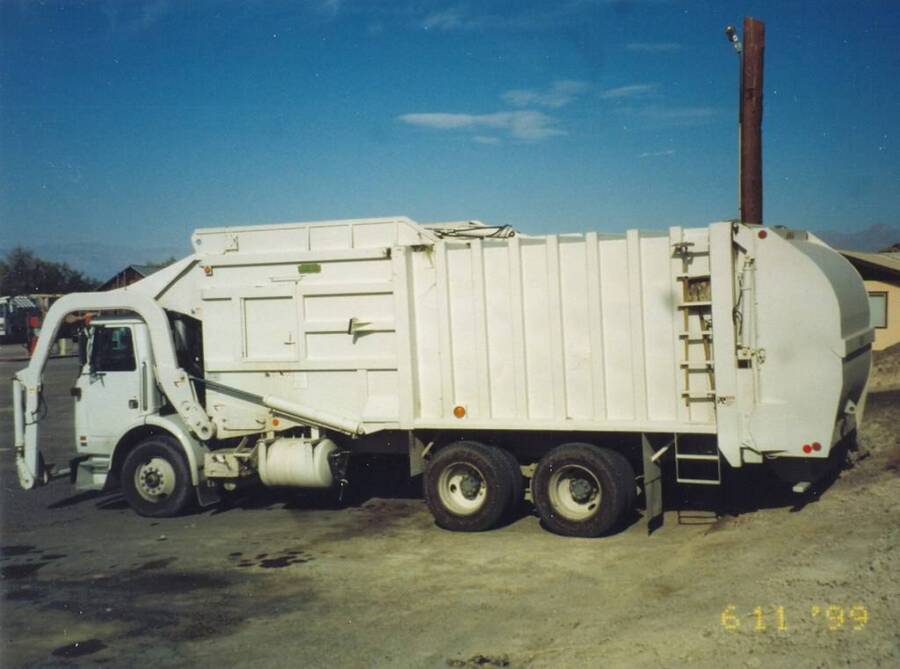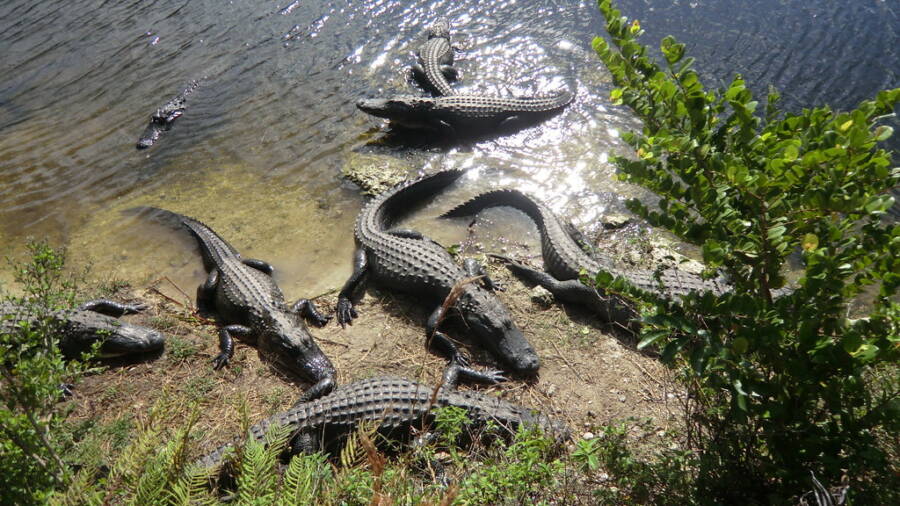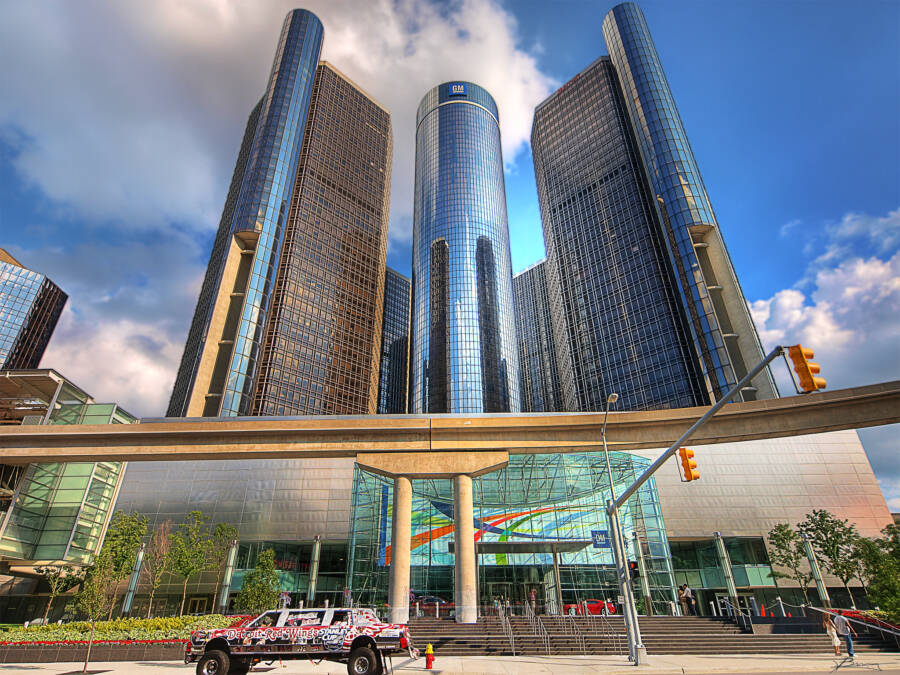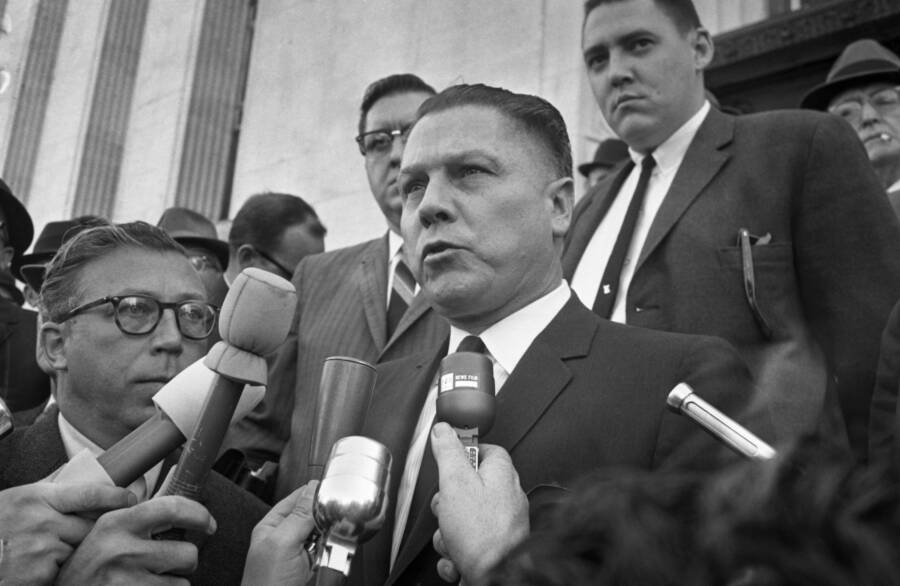Though many believe that he was killed by the Mafia, Jimmy Hoffa's body has never been found and the truth about what happened to him remains a mystery.
Ever since Jimmy Hoffa’s disappearance on July 30, 1975, the mystery surrounding what happened that day has taken on an almost-mythic quality, so much so that it eclipses nearly everything else about him, which was no easy feat. To this day, Jimmy Hoffa’s death overshadows almost the entirety of his historic life.
Once the head of the powerful and corrupt Teamsters Union, Jimmy Hoffa was a household name long before he vanished and the apparent ease with which he was simply erased was impossible to believe.

Robert W. Kelley/The LIFE Picture Collection/Getty ImagesJimmy Hoffa at the Teamster’s Union Convention in 1957.
Not about to be second to anyone in stature, even in his disappearance, it seems appropriate that Hoffa would live on as one of America’s most famous missing persons.
He became the cultural embodiment of what happened to those who ran afoul of the mob in the 1970s — at least in the public imagination — and decades later, we still can’t seem to help ourselves from speculating about Jimmy Hoffa’s death and what truly happened to him all those years ago.
Who Was Jimmy Hoffa?
Born James Riddle Hoffa on February 14, 1913, his family moved to Detroit when he was young and he would call the area home for the rest of his life. Hoffa’s union organizing began when he was a teenager working at a Kroger grocery store warehouse, where the substandard wages, abusive supervisors, and lack of job security inspired animosity from the employees.
Approachable and courageous, Hoffa showed early leadership potential during a wildcat strike of the warehouse workers that led to better pay and conditions so when he quit in 1932, he was quickly hired by the Teamsters Local 299 as an organizer. It was the beginning of an association with the Teamsters that would come to define Hoffa’s life for more than 50 years.
Over the course of his career in the Teamsters, Hoffa became its most recognizable public face and a fiery, aggressive advocate for trade unionism in America. His televised confrontations with Senator Robert Kennedy during a Senate committee hearing on corruption in America’s labor unions made Hoffa a household name, endeared him to millions of working Americans who saw him as championing their cause.

Wikimedia CommonsJimmy Hoffa and his son, James P. Hoffa, in 1965.
Jimmy Hoffa’s ties with organized crime figures were well-documented and publicized, and for most of his life he was able to leverage these associations to strengthen the Teamsters Union, growing it into one of the most powerful unions — if not the most powerful — in the country.
The devil’s bargain that Hoffa cut with the mob caught up with him in the end, however. When the interests of the Teamsters membership and those of the Mafia began to diverge in the 1970s, Hoffa and the mob found themselves at cross purposes to one another.
With neither side willing to back down, the potential for an outbreak of nationwide violence between mob factions caught up in the fight was a very real possibility.
It never came to that, though, because Jimmy Hoffa simply disappeared on July 30, 1975, and was never seen or heard from again. The investigation captivated America and the intersection of so many cultural threads in one case meant that Jimmy Hoffa’s death was destined to evolve over the next couple of decades into one of America’s most enduring cultural memes.
Theories About Jimmy Hoffa’s Death
So what happened to Jimmy Hoffa?
What we know is that Jimmy Hoffa was last seen in the parking lot of the Machus Red Fox restaurant in Bloomfield Township, Michigan on July 30, 1975. Hoffa had agreed to meet with a few of the key mobsters at the heart of the dispute between himself and the Mafia families that had slowly been taking over many of the Teamsters Locals around the country.
Ostensibly meeting to settle their dispute over leadership and control of the Teamsters, the meeting was clearly a set-up for the murder of the powerful labor leader.
Even though the presumption is that Hoffa was killed by a mob hitman, his body has never been found. Additionally, investigators could not build a strong enough case to charge any of the mob-connected figures who were most likely involved in the murder. The case remains an open investigation to this day, though Jimmy Hoffa was officially declared dead in 1982.
The reality is that nobody knows for sure what happened to the infamous union leader and no forensic investigation to date has ever amounted to anything approaching a clear picture of what happened to him. Still, theories about Jimmy Hoffa’s death abound; many of them are well-known and adequately gruesome to garner continued public fascination.
In fact, Jimmy Hoffa’s body has suffered so much hypothetical abuse at the hands of the mob that it has transformed into the cultural meme that it is today.
Was The Teamster Leader Buried At Giants Stadium?
Arguably the most well-known theory about Jimmy Hoffa’s disappearance is that he was shot, dismembered, frozen, and then buried in the cement foundation of Giants Stadium, then-located in East Rutherford, New Jersey.
This story of Jimmy Hoffa’s death first entered the public consciousness in 1989 when Donald Frankos gave an interview to Playboy Magazine where he claimed that Hoffa was killed by a New York Irish mafia boss by the name of Jimmy Coonan and buried at the home field of the New York Giants and New York Jets football teams.
According to Frankos, after Coonan shot Hoffa with a silenced .22-caliber pistol in a house in Mt. Clemens, Michigan, he and New York Mafia hitman John Sullivan cut up Hoffa’s body with a power saw and meat cleaver, bagged up the body parts, and stored them in a freezer for months.
Later, the bags were driven to the open construction site of Giant Stadium — which opened the following year — and the bags were mixed into the concrete foundation under what became section 107. This section was located near the end zone of the stadium’s football field. A stadium map marking the spot Hoffa was buried was printed along with the story under the headline “Hoffa Goes Deep.”
According to Frankos, Coonan and an accomplice told him how the murder went down after the fact, and Frankos claimed that he told the F.B.I. about it in 1986. Though the F.B.I. took the allegations seriously in 1989, Frankos — who was in federal witness protection ahead of his testimony against New York crime boss John Gotti — didn’t have much to back up the claim. Investigators connected to the Hoffa case also disputed that Frankos told any of this to the F.B.I. in 1986.
Without physical evidence to support this theory regarding Jimmy Hoffa’s death, it was eventually written off as just the latest Hoffa story in a long line of similar accounts. When Giants Stadium was demolished in 2010, the F.B.I. didn’t even bother to show up and search the site.
The Alleged Involvement Of Frank “The Irishman” Sheeran

YouTubeFrank “The Irishman” Sheeran, a known mafia hitman who claimed that he killed Jimmy Hoffa.
Before Jimmy Hoffa’s death, a mobster and former friend of his named Frank “The Irishman” Sheeran, claimed that he carried out the hit on Hoffa on orders from the boss of the Philadelphia mob, Russell Bufalino.
Sheeran said that he betrayed his friend and personally pulled the trigger because the hit on Jimmy Hoffa was a foregone conclusion by that point. If someone was going to do it, Sheeran felt, it should be him.
According to Sheeran’s 2004 biography I Heard You Paint Houses, written by former prosecutor Charles Brandt, Hoffa never saw it coming. “My friend didn’t suffer,” Sheeran said, claiming that after he brought Hoffa to a house in northwestern Detroit, he stood behind Hoffa while he was distracted and shot him twice in the back of the head.
Jimmy Hoffa’s dead body was then cremated in a trash incinerator in the Detroit suburbs. Sheeran gave the address of the house where the murder supposedly took place and investigators searched the site for evidence of the killing. They found traces of blood in the house but later testing revealed that it didn’t belong to Hoffa.
No other evidence was found that gave any support for Sheeran’s claim, leading both law enforcement officials and journalists who covered Hoffa’s disappearance to disregard Sheeran’s “confession” as almost entirely fabricated.
Don’t expect this theory about Jimmy Hoffa’s death to fade out with time, however. Brandt’s book is the source material for the 2019 Martin Scorsese film The Irishman, so many of Sheeran’s claims are likely to get a lot of new life and will probably become more entrenched in the culture as a result.
The Truth About Jimmy Hoffa’s Disappearance Becomes Buried Under Wild Leads

Mark Halloway/FlickrIn one theory about Jimmy Hoffa’s death, he was murdered and his body dumped into a trash compactor of an area restaurant. Mob-connected garbage collectors would then haul the contents of the compactor to the dump, finding Hoffa’s body forever.
There are a dozen variants of the same basic formula about Jimmy Hoffa’s disappearance, with the gist of the tale being a quick mob execution followed by some industrial process that destroys Hoffa’s body in an appalling way. The remains are then dumped somewhere that is impossible to search, or Hoffa’s corpse was so thoroughly annihilated that dumping was not necessary.
This story formula was introduced only a few months after Hoffa disappeared when police received a tip pointing them to the Raleigh House restaurant in Detroit.
Like many restaurants, the Raleigh House used an industrial trash compactor for their waste, which was regularly emptied by a waste management company with ties to organized crime. Tips to investigators indicated that after Hoffa was killed, his body was thrown into the trash compactor at Raleigh House, eventually ending up in a garbage dump.
Following up those tips, in September and October 1975 investigators interviewed employees and searched the grounds and the compactor for evidence. Nothing was found, but by then reports had made it into the collective consciousness of the country and the core fixtures of a good Jimmy Hoffa disappearance story took root.
Why Some Say Federal Agents Were Behind Jimmy Hoffa’s Death

Brenda Timmermans/PexelsOne theory of Jimmy Hoffa’s death is that a pair of federal agents took him up in a private plane and threw him out the door when they were several thousand feet above one of the Great Lakes.
As the various theories about Jimmy Hoffa’s disappearance took on lives of their own, the other major element of the cultural meme around the case began to emerge. Mobsters on the lower rungs of the mafia hierarchy tried to up their profiles through the press by claiming that they knew the truth about the case, but for some arbitrary reason, they kept it to themselves until now.
One such account of Jimmy Hoffa’s death is from Joseph Franco, a former associate of Hoffa’s and a self-proclaimed “thief, extortionist, leg breaker, and hired killer.” According to Franco, a pair of federal agents abducted Hoffa, took him up in an airplane, and threw him out somewhere over one of the Great Lakes.
Besides being almost comically preposterous, Franco claims there was a legitimate reason why he’d kept the story to himself: he was trying to use this knowledge as leverage in negotiating an immunity deal from federal prosecutors.
Shockingly, they did believe Franco’s story.
The Theory That Jimmy Hoffa’s Body Was Fed To Alligators

Reinhard Link/FlickrAccording to one story, after Jimmy Hoffa was killed, his body was ground up, put in a steel drum, and shipped to Florida. His remains were then dumped in the alligator-infested Everglades.
By 1985, an industry was starting to build up to keep fresh stories and theories about Jimmy Hoffa’s disappearance in the popular imagination. Even people who were supposed to keep their heads down and shut up for their own safety couldn’t help but get in on the act.
Charlie Allen, a former mob hitman and one-time bodyguard for Hoffa who had been in witness protection for nearly a decade, gave an interview to the Richmond Times-Dispatch claiming that Hoffa was abducted, shot with a stun gun, and then murdered on orders from an unnamed crime boss whom Hoffa had allegedly tried to have killed. “[T]hings got messed up, and he got to Jimmy first,” Allen told the reporter.
In keeping with the now-familiar formula, Hoffa’s body was ground up at an ironworks, placed into a steel drum, and shipped to the alligator-infested waters of the Florida Everglades, where his remains were subsequently dumped and presumably eaten by the local fauna.
Was He Buried Beneath Detroit’s Renaissance Center?

paul bica/FlickrOne urban myth claims that Jimmy Hoffa’s remains were buried beneath the Renaissance Center in downtown Detroit.
As the mystery around Jimmy Hoffa’s disappearance dragged on for years, Detroit, Michigan was particularly engaged in the fate of one of its most famous residents. Bridges, overpasses, just about anywhere a structure went up after 1975, you could probably find someone who’d say that it was built over the bones of Jimmy Hoffa.
The most famous of these is the Rennaissance Center in downtown Detroit. According to Mafia chauffeur-turned-informer Marvin Elkind, Jimmy Hoffa was kidnapped, killed, etc., and then buried in the wet concrete foundation of the building.
Elkind’s telling of this story has the kind of hyperbolic flourish that has become a characteristic of a good Jimmy Hoffa theory, as quoted in the New York Post in 2011: “practically every union carpenter in and around the city was called in to rush the construction of wooden forms needed for pouring concrete at the Renaissance project.”
The Theory That He Was Sold As Scrap Metal To The Japanese Auto Industry

PixabayAccording to one mobster, after he was killed, Jimmy Hoffa’s body was put in a car and crushed by a scrap yard press, which was then sold to Japanese automakers as scrap metal.
The theory Jimmy Hoffa might have hated the most were he alive to hear it is the one told by mob hitman Richard Kuklinski just before he died back in the mid-2000s.
According to Kuklinski, Jimmy Hoffa was stabbed in the head and killed with a hunting knife, then his body was placed in the boot of Kuklinski’s car. Kuklinski then drove the car to New Jersey and had it crushed in a scrap metal press in a junkyard — with Hoffa’s body still in.
Kuklinski suggests the compacted metal was then shipped overseas to Japanese automakers as scrap metal. “He’s part of a car somewhere in Japan right now,” Kuklinski said.
As investigative reporter Jerry Stanecki wrote in The New York Times, it was “the ultimate insult — a nonunion market.”
The Official Report On Jimmy Hoffa’s Disappearance

Getty ImagesJimmy Hoffa was last seen standing outside the Machus Red Fox Restaurant in Bloomfield Township on July 30, 1975.
The official F.B.I. report on the Jimmy Hoffa case, the so-called “Hoffex Memo,” suggests a motive, but not a method. According to the Chicago Tribune:
“The memo says a plan was conceived in New Jersey by Teamsters with ties to the Mafia to stage a hit on Hoffa in Detroit. According to federal authorities, the hit was set up out of fear of Hoffa’s possible return to power in the Teamsters.”
Specifically, the memo suggests that Hoffa was killed so that he wouldn’t once again gain control of the shady Teamsters Central States Pension Fund, which was worth around a billion dollars unadjusted for inflation.
Hoffa’s son, James P. Hoffa, elected head of the Teamsters in 1999, agreed that the Mafia was involved and even ran his campaigns on the back of that conviction. “The mob killed my father. If you vote for me, they will never come back,” he told a crowd of truck drivers in 1996.

Bettmann/Getty ImagesInternational Teamsters President James R. Hoffa makes a final statement to the press after a federal judge had just sentenced him to eight years in prison and fined him $10,000 for jury tampering during the 1962 trial in Nashville.
But even if most people agree that the mob was responsible for Jimmy Hoffa’s death, there remains the continued fascination with the whereabouts of Hoffa’s body more than 40 years later. As NPR’s Alan Greenblatt suggested in 2013, that fascination is instinctual: “Everyone knows we all must die, but people who go missing entirely tap into primal fears.”
Paradoxically, as Bob Thompson, a professor of pop culture at Syracuse University told Greenblatt, the public-at-large might not actually want this case demystified, noting, “Closure is the death knell to these kinds of things.” The lurid, almost entirely imaginary details of the case are enchanting precisely because their veracity seems, at this stage, forever unknowable.
Like Amelia Earhart, perhaps the most famous missing person in history, Jimmy Hoffa’s disappearance has become legendary. The truth, if it’s even obtainable, would be a loss of a different kind, as historian Katrina Gulliver notes.
“A lingering absence begets its own mythology: the claimed sightings, the clues, the purported explanations,” she wrote on the 75th anniversary of Earhart’s disappearance. “By disappearing, these people in a sense never die. They remain frozen in time, even as the world changes. In our collective imagination, they are still out there.”
Enjoy this article on Jimmy Hoffa’s death and his mysterious disappearance? Next, hear from one expert criminologist who recently claims to have solved the Jimmy Hoffa mystery once and for all. Then, read about the mob boss who may have been involved in Hoffa’s disappearance, Angelo Bruno.





